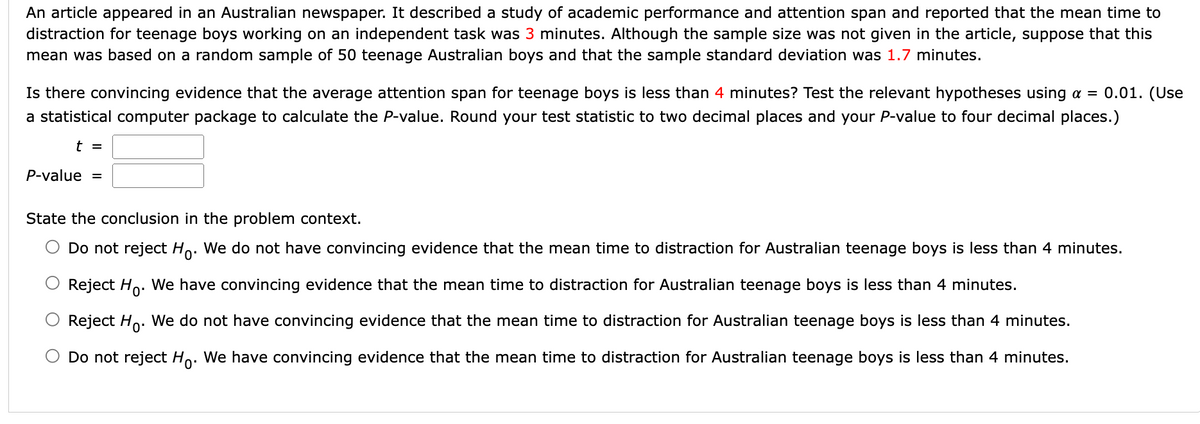An article appeared in an Australian newspaper. It described a study of academic performance and attention span and reported that the mean time to distraction for teenage boys working on an independent task was 3 minutes. Although the sample size was not given in the article, suppose that this mean was based on a random sample of 50 teenage Australian boys and that the sample standard deviation was 1.7 minutes. Is there convincing evidence that the average attention span for teenage boys is less than 4 minutes? Test the relevant hypotheses using a = 0.01. (Use a statistical computer package to calculate the P-value. Round your test statistic to two decimal places and your P-value to four decimal places.) t = P-value = State the conclusion in the problem context. O Do not reject Ho. We do not have convincing evidence that the mean time to distraction for Australian teenage boys is less than 4 minutes. O Reject Ho. We have convincing evidence that the mean time to distraction for Australian teenage boys is less than 4 minutes. O Reject Ho. We do not have convincing evidence that the mean time to distraction for Australian teenage boys is less than 4 minutes. O Do not reject Ho. We have convincing evidence that the mean time to distraction for Australian teenage boys is less than 4 minutes.
An article appeared in an Australian newspaper. It described a study of academic performance and attention span and reported that the mean time to distraction for teenage boys working on an independent task was 3 minutes. Although the sample size was not given in the article, suppose that this mean was based on a random sample of 50 teenage Australian boys and that the sample standard deviation was 1.7 minutes. Is there convincing evidence that the average attention span for teenage boys is less than 4 minutes? Test the relevant hypotheses using a = 0.01. (Use a statistical computer package to calculate the P-value. Round your test statistic to two decimal places and your P-value to four decimal places.) t = P-value = State the conclusion in the problem context. O Do not reject Ho. We do not have convincing evidence that the mean time to distraction for Australian teenage boys is less than 4 minutes. O Reject Ho. We have convincing evidence that the mean time to distraction for Australian teenage boys is less than 4 minutes. O Reject Ho. We do not have convincing evidence that the mean time to distraction for Australian teenage boys is less than 4 minutes. O Do not reject Ho. We have convincing evidence that the mean time to distraction for Australian teenage boys is less than 4 minutes.
MATLAB: An Introduction with Applications
6th Edition
ISBN:9781119256830
Author:Amos Gilat
Publisher:Amos Gilat
Chapter1: Starting With Matlab
Section: Chapter Questions
Problem 1P
Related questions
Question

Transcribed Image Text:An article appeared in an Australian newspaper. It described a study of academic performance and attention span and reported that the mean time to
distraction for teenage boys working on an independent task was 3 minutes. Although the sample size was not given in the article, suppose that this
mean was based on a random sample of 50 teenage Australian boys and that the sample standard deviation was 1.7 minutes.
Is there convincing evidence that the average attention span for teenage boys is less than 4 minutes? Test the relevant hypotheses using a = 0.01. (Use
a statistical computer package to calculate the P-value. Round your test statistic to two decimal places and your P-value to four decimal places.)
t =
P-value =
State the conclusion in the problem context.
Do not reject Ho. We do not have convincing evidence that the mean time to distraction for Australian teenage boys is less than 4 minutes.
Reject Ho. We have convincing evidence that the mean time to distraction for Australian teenage boys is less than 4 minutes.
Reject Ho. We do not have convincing evidence that the mean time to distraction for Australian teenage boys is less than 4 minutes.
Do not reject Ho. We have convincing evidence that the mean time to distraction for Australian teenage boys is less than 4 minutes.
Expert Solution
This question has been solved!
Explore an expertly crafted, step-by-step solution for a thorough understanding of key concepts.
Step by step
Solved in 2 steps with 2 images

Recommended textbooks for you

MATLAB: An Introduction with Applications
Statistics
ISBN:
9781119256830
Author:
Amos Gilat
Publisher:
John Wiley & Sons Inc

Probability and Statistics for Engineering and th…
Statistics
ISBN:
9781305251809
Author:
Jay L. Devore
Publisher:
Cengage Learning

Statistics for The Behavioral Sciences (MindTap C…
Statistics
ISBN:
9781305504912
Author:
Frederick J Gravetter, Larry B. Wallnau
Publisher:
Cengage Learning

MATLAB: An Introduction with Applications
Statistics
ISBN:
9781119256830
Author:
Amos Gilat
Publisher:
John Wiley & Sons Inc

Probability and Statistics for Engineering and th…
Statistics
ISBN:
9781305251809
Author:
Jay L. Devore
Publisher:
Cengage Learning

Statistics for The Behavioral Sciences (MindTap C…
Statistics
ISBN:
9781305504912
Author:
Frederick J Gravetter, Larry B. Wallnau
Publisher:
Cengage Learning

Elementary Statistics: Picturing the World (7th E…
Statistics
ISBN:
9780134683416
Author:
Ron Larson, Betsy Farber
Publisher:
PEARSON

The Basic Practice of Statistics
Statistics
ISBN:
9781319042578
Author:
David S. Moore, William I. Notz, Michael A. Fligner
Publisher:
W. H. Freeman

Introduction to the Practice of Statistics
Statistics
ISBN:
9781319013387
Author:
David S. Moore, George P. McCabe, Bruce A. Craig
Publisher:
W. H. Freeman